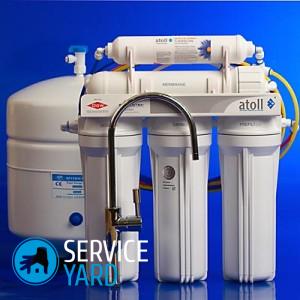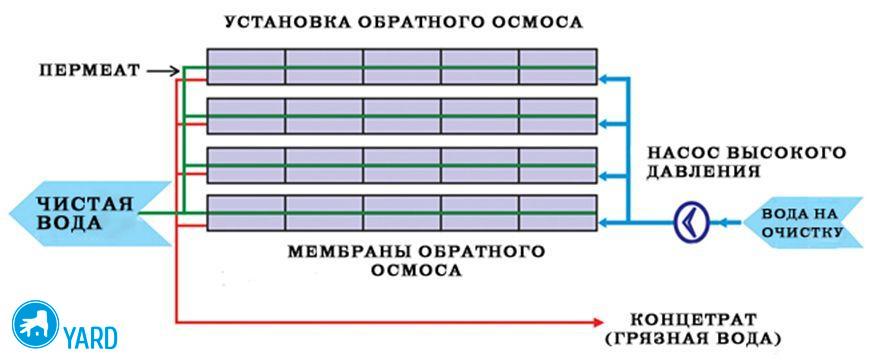Reverse osmosis

Today, every second person living in an ordinary city apartment uses water purification systems that flow from the tap, because it contains many impurities that are harmful to health. Reverse osmosis will allow you to quickly solve this problem, but whether it is necessary to do this, is it really necessary to spend personal time, money and effort on water treatment. We will deal with this issue in this article, as well as with what reverse osmosis is and how effective it is.
to contents ↑Is tap water filtration necessary?
The opinion of the great contamination of tap water is quite controversial, because most recently all people drank it and did not think about any negative consequences. In large cities, water quality is strictly controlled, therefore, in principle, it is not necessary to purify it additionally.
Manufacturers of such purifiers are able to find an approach to ordinary people and to convince that our water really can’t just be drunk. Therefore, products for filtration - jugs, coolers, have become so popular in our time. But in fact, no special devices are needed to purify the water entering the apartment from the old rusty water supply, you just need to install a mechanical filter in the apartment or several filters that work in turn.
An ideal technology for water purification is reverse osmosis. Let's get to know him better in order to understand whether he is so needed in every apartment.
to contents ↑What is reverse osmosis?
This filter works on the basis of the use of a reverse osmosis membrane, capable of purifying water from all kinds of impurities that exist today. In fact, the ancient Greeks used a similar technology - they passed sea water through the walls of a vessel made of wax, and it became fresh.
In the sixties they began to use industrial plants that helped turn seawater into fresh water. Due to the fact that the reverse osmosis filter was maximally improved, it began to be used not only in industrial conditions, but also in residential buildings.
to contents ↑Important! As a result of this treatment, the water becomes crystal clear and safe, in its properties it is very similar to the meltwater of ancient glaciers.
Truth and myths about reverse osmosis
According to experts and ordinary people, water purified using this technology is ideal for daily use. Scientists have been arguing about this for more than a year. And even today there are a lot of erroneous opinions and myths, as well as misconceptions about reverse osmosis.
Consider myths that have no confirmation in order to dispel false ideas about him once and for all:
First myth
Reverse osmosis purifies water from healthy mineral compounds. No company respecting itself and its customers will claim this, since this filter actually kills only:
- viruses and bacteria;
- radionuclides;
- heavy metals;
- inorganic and organic compounds as well as suspensions.
Important! Yes, it removes minerals, but only those related to inorganic pollutants.
Second myth
Purified water gets rid of minerals important for life. This is a huge misconception, since it actually remains after purification at its inherent properties.
Water works like a magnet: it collects mineral substances that are discarded, rejected and unnecessary by the body and, through lymph and blood, delivers them to the kidneys and lungs for subsequent excretion.
Third myth
The reverse osmosis system negatively affects the condition of the teeth. And this is also a mistake, because on the contrary - people who constantly use purified water are less likely to encounter problems regarding their teeth.
Myth Four
Many believe that purified water in this way loses its taste. In fact, taste is the main reason for buying bottled water. Most consumers are convinced that it is minerals that give water a taste. But in reality, it becomes so because of the presence of oxygen. Normal water should not have a metallic aftertaste.
to contents ↑Important! The water obtained after cleaning with such a filter is ideal for drinking and cooking, and is the cleanest and safest.
More on reverse osmosis membrane
The membrane installed in the filter is a composite polymer that can be characterized by uneven density, and it consists of two layers connected inextricably with each other. The first layer serves as a barrier.
A membrane is a kind of filter that meets all the requirements, and due to this, the water passing through it gets rid of unnecessary mineral impurities. Osmosis for water purification during operation is slowly contaminated and this negatively affects the functioning of the installation itself. To restore its properties and specified operational characteristics, you need to thoroughly wash the device, by backwashing with a stream of water or by blowing with compressed air.
to contents ↑Important! To extend the life of your filter, it is recommended that chemicals be added to the waste water to help fight sludge formation. Most often, an inhibitor or sulfuric acid is used as such reagents.
The installation of reverse osmosis
Such units are arranged in different ways, because everything depends on the water that is being treated and the conditions under which this process is carried out. But nevertheless, there is a standard equipment that requires the presence of such functional elements:
- Pre-filter - it helps to prepare water for the main process and involves the removal of particulate matter no larger than 5 microns.
- Filtration block - designed to install membranes involved in the process of water purification.
- The pump, which creates the necessary fluctuations in pressure, thereby providing a reverse outflow of water.
- The strapping of the filtration unit is for its safe operation.
- Instrumentation and control tools - for automatic control of the unit.
- Flushing unit - designed to clean the membrane surface to improve the quality of the installation.
to contents ↑Important! You can also install additional cartridges that will perform several more useful functions, due to which the reverse osmosis system will work more efficiently:
- Ionizer - helps saturate water with positive ions and eliminate negative ones. The resulting water is much more easily absorbed by the body and normalizes the pH level, as well as perfectly detoxifies.
- Mineralizer - due to it, in the process of water purification, it is saturated with salts and minerals that support the saline solution in the body.
- Cartridge for softening water - removes heavy metal salts, which contribute to the formation of scale on the elements of a washing machine, dishwasher, as well as on dishes.
- Bioceramic cartridge - restores the structure of water, which it has by nature.
Stages of water purification by installing a reverse osmosis system
The standard scheme for water purification using such an aggregate is five-stage and consists of several stages, following the sequence of which in the end we get clean and healthy water.
Important! Reverse osmosis involves the passage of water after mechanical cleaning through a special membrane containing many microscopic holes. They trap dirt, washed off into the sewer by a stream of water.
The very first and obligatory stage of water purification is preliminary mechanical treatment, which involves the passage of water through a whole system of cartridges:
- Filter for deep cleaning. It is capable of retaining the largest mechanical particles (rust and sand).
- Coal block. It purifies water from phenols, heavy metals, petroleum products and chlorine.
- Fine cartridge. At this stage, additional water purification is carried out, namely the removal of the smallest particles.
- In the next step, water passes through a reverse osmosis membrane.
- After filtering the water through the membrane, it accumulates in a sealed container made of plastic or metal, divided into two parts by a rubber membrane. In this case, on the one hand, air is pumped into the tank, and on the other hand, water is poured.
- The fifth stage of cleaning is a carbon filter. Water under pressure is pushed out of the tap and undergoes final cleaning.
How to choose the ideal filter for yourself?
The reverse osmosis filter should be selected based on the following criteria:
- Decide what kind of water you need. You need to make this decision in order to determine the number of the required number of modules.
- Find out under what pressure water comes to you through the water pipes. This is important because filtration through the membrane can only occur under pressure of at least three milliamps. Otherwise, you will have to buy an additionally mounted or built-in pump.
- Decide if you need a mineralizer and an ultraviolet emitter.
- Decide when choosing a filter whether it should have an infrared module that makes water more useful.
- The choice of a membrane deserves special attention, and it is better if it has a special coating that protects it from accumulation of dirt. Such membranes last much longer.
Important! In addition to all of the above points, you also need to take into account the amount of filtered water that your family consumes per month to select the unit of the desired volume.
All failed filter elements must be replaced immediately, because the quality of the water consumed and your health will depend on this.
to contents ↑Stock footage
Now you have a full understanding of what reverse osmosis is, how it is designed and functions, how useful it is in everyday life, and whether its installation will be reasonable. We hope you made the right decision and protected yourself from the dubious quality of water once and for all in such a simple way, without the regular purchase of various water purification devices or expensive bottles of mineral water.
- How to choose a vacuum cleaner taking into account the characteristics of the house and coatings?
- What to look for when choosing a water delivery
- How to quickly create comfort at home - tips for housewives
- How to choose the perfect TV - useful tips
- What to look for when choosing blinds
- What should be running shoes?
- What useful things can you buy in a hardware store
- Iphone 11 pro max review
- Than iPhone is better than Android smartphones



